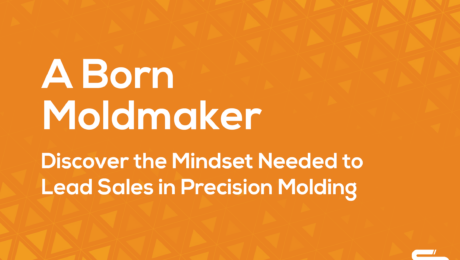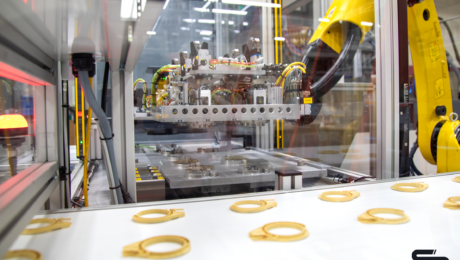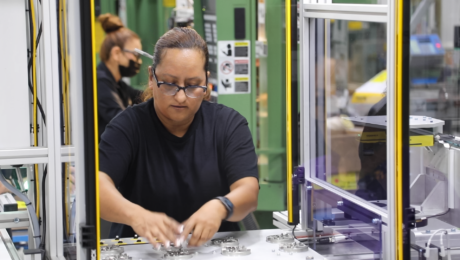I’ve spent almost 50 years in mold making and precision injection molding. Here’s what it takes to succeed.
Written by John Linder, Director of Sales and Marketing

As I prepare to retire from a nearly 50-year career in mold making and precision injection molding, I find myself with an unusual and challenging task: finding my replacement. I’ve been lucky enough to have had a career that’s branched out into many different directions, so I think the best way to find someone to fill my shoes is to tell my story and share how I’ve acquired my skills. Maybe you’ll read this and discover we have some things in common.
A Born Moldmaker
I must start by looking at what shaped me and my long career path. I am a third-generation tool/mold maker. My father owned a mold making and injection molding company, so I was exposed to molding at a young age. I loved building model cars, which had me dealing with molded parts, runner systems, and the like.
I exhibited a God-given talent for craftsmanship at a young age, excelling in woodshop and drafting classes while in middle school. By high school, I had taken aptitude tests that confirmed I have a high level of mechanical aptitude. A mold maker must be able to see the opposite side of the surface in order to know what the mold will look like, and not everyone can easily see in reverse.
Old-School Methods
I started my mold making career in an era that was pre-CAD/CAM, wire EDM and HS machining. We had to learn what is today considered very outdated machining techniques. We did much of our own mold design work. Even handheld calculators were uncommon. This old-school environment taught me many valuable lessons that are hard to replicate.
Breaking into the Mold
About nine years into my career, I moved over to the molding side of the business. Learning how a mold operates in serial production was an invaluable lesson. As my career progressed, I managed the technical portion of the molding business. This included managing the engineering function. I started buying and then selling internationally built molds. As my career progressed, I became more involved with secondary operations and assembly work. I have always embraced technology, and things like mold simulation software and additive manufacturing have brought interesting learning experiences and opportunities.
Agility is Key: Moving into Sales and Admin
With a little over 40 years in the business, I moved into the sales role full-time. I have always contributed to the sales function throughout my career, and having a technical background is very important. Customers want to speak with an intelligent and knowledgeable salesperson. Part of this technical knowledge must include the ability to conceptualize and brainstorm on new product designs and manufacturing processes. In my role, I am the one who reviews all new opportunities to determine if the project is a good fit for our capabilities. Being able to easily envision a new concept is key to being effective.
A considerable amount of my time is spent on administrative functions. I am the gatekeeper for pricing. I read every contract and proposal coming into the company. With the advent of some new European laws and regulations, we must deal with many new environmental and human rights initiatives and requirements.
Do You Have What It Takes?
Selling today has taken a dramatic turn post-COVID. Today, online presence and online marketing is everything. Old-fashioned door knocking and relationship building is simply ineffective. In this role, having the ability to produce interesting technical articles is critical in attracting new leads. Managing a marketing partner and what is posted online is vital to how you are perceived online. This information is what drives new leads to the sales funnel. Understanding CRM programs and how to use them effectively is a very important tool for growth.
I have been truly blessed to have had such a wonderful career. I know that there are only a few people who have had similar experiences. Understanding mold making and injection molding, as well as possessing experience and knowledge of both, is fundamental. If you have the skills and knowledge outlined in the story and are interested in learning more about this position, email me at jlinder@chemtechplastics.com.
- Published in Uncategorized
How to Advance Injection Molding with Automation
The world is constantly changing. New trends and technologies are emerging seemingly every day. In recent years, automation has become one of the hottest topics in manufacturing, playing an increasingly prominent role throughout the industry – and injection molding is no exception. In order to become an industry leader, it’s essential to implement cutting-edge technologies like automation.
This blog will explain the impact of automation in manufacturing, how automation can be utilized in injection molding, what the benefits are, and how Chemtech has positioned itself as an automation trailblazer.
Automation in Manufacturing
Automation is an umbrella term that contains many distinct technologies, so automation will present itself in different ways at different manufacturers. Each company will take on the technologies that make the most sense for its specific facility. The most common uses for automation in manufacturing are robotics and software integration.
When you think of automation, robots are likely the first image that comes to mind. And that’s for good reason; factory robots have been in use since 1961. Since then, they have taken over many parts of the assembly line. Three-axis or six-axis robotic arms can be preferable to human labor in situations that demand heavy lifting or high volumes, particularly in picking-and-sorting situations, because they can implement repeatable processes at a faster rate than a human worker can.
Robotics technology has moved past robotic arms and into new areas that integrate software. For example, manufacturers can apply vision systems that allow robots to scan, or “see,” their surroundings and perform more advanced tasks than sorting and picking; these robots can recognize and select components from bins of assorted materials and inspect the components for quality control with micro-level precision.
The Internet of Things (IoT) is also widely used today. In manufacturing, IoT can sync a factory’s robotics with the rest of its operations by uploading data from each robot into one network that also contains all other operational data. This increased connectivity enables manufacturers to easily track their processes from start to finish and implement solutions to increase efficiency.
Applications for Automation in Injection Molding
So, how does all of this apply to injection molding? Automation tools can ensure that injected parts are properly made and measured. They can also perform stringent quality control checks. By replacing manual labor with automated robotics in key areas of the assembly line, automated machines can prevent defects by maintaining precision and handling delicate parts at a level that human labor cannot match.
There are a number of specific ways that automation can streamline production:
- Machine tending: this includes implementing automated tools to complete standard tasks like unloading parts and removing runners.
- Insert molding: automated tools can safely and accurately add inserts during the manufacturing process.
- Overmolding: automated tools can quickly move injected molded parts between machines and combine them without damaging either part.
- Post-processing: plastic injection manufacturers can employ automated machines to handle standard post-processing tasks like trimming excess material from a part, evenly dispensing a sealant, quality control checks, cleanup, and even some packaging and shipping tasks like sealing parts for shipment and moving them into containers.
Benefits of Automation in Injection Molding
In a world where governments are beginning to legislate waste reduction efforts and customers are looking for new ways to promote sustainability, it’s imperative to implement automation tools to curb waste and tighten up manufacturing processes.
Automation tools can easily reduce waste in injection molding manufacturing. By installing robotic tools that improve part consistency, manufacturers will see cost savings stem from an overall boost in consistency and quality that reduces the number of bad batches and material waste.
Cost savings is another area of concern for manufacturers; according to the Institute for Supply Management, “supply prices rose 4.1% in 2023 and have spiked a whopping 25% since 2020.” Implementing automated tools will cut costs by creating a more efficient workflow that produces parts faster. This is particularly beneficial for the many industries served by injection molders that require a high-volume output. Automation also saves on the cost of labor, which is projected to rise each year. Automated tools reduce the amount of human labor necessary in manufacturing, thus reducing the amount of labor expenses.
How Chemtech Plastics Streamlines Production with Automation
Automation plays a huge role at Chemtech. We recognize the potential for this technology to revolutionize our workflow, and we are always seeking out new ways to add it into our processes.
We have established an in-house automation team, led by an experienced automation engineer. Our automation team implements these technologies in a number of ways, such as incorporating robots, conveyors, and enhanced safety systems.
At any given time, we have multiple automation cells, with varying levels of sophistication, in operation at our facility. As much as this benefits our clients, it’s also beneficial to our highly skilled employees by allowing them to utilize their time more productively.
Chemtech Plastics is on a mission to champion the highest quality injection molding products by efficiently delivering precision technology – automation foremost amongst them – through absolute reliability and support to our clients. We are the solution to all of your injection molding needs. Contact us today to learn how we can support your industry.
- Published in Uncategorized
How to Design for Assembly with Plastic Injection Molding
OVERVIEW
Every manufacturer wants to create the most efficient processes at the lowest cost. But how do you get there? One crucial methodology to apply to your manufacturing process is Design for Assembly (DFA). Designing for Assembly means that you consider questions like how many parts are incorporated into your assembly process, how many people are working on it, and how long it will take to bring a product to market. The end result after applying all of these considerations is a personalized and streamlined assembly process.
This article will explain what DFA is, illustrate why it’s important, list the five pillars of DFA, describe how DFA applies to plastic injection molding, and share how Chemtech Plastics utilizes DFA.
WHAT IS DFA?
DFA is a product design methodology that helps manufacturers develop products that can be assembled more easily. 1 It is a core consideration in the design process. DFA aims to effectively reduce production and labor costs, time, and any challenges that may arise during the assembly and manufacturing processes.2
DFA was first developed by Geoffrey Boothroyd, a professor at the University of Massachusetts Amherst, in the late 1970s.3 DFA is implemented from the very beginning of the manufacturing design process; Boothryod states that the goal of DFA is “to create a clearly defined procedure for evaluating a design with respect to its ease of manufacture and assembly,” and this is achieved by “providing manufacturing input at the conceptualization stage of the design process in a logical and organized fashion.”4
In order to meet these goals, those employing the DFA process look for ways to design parts that are easy to assemble and disassemble, parts that are interchangeable, an assembly process that is simple, and a product that is safe to assemble and use.1
WHY DFA IS IMPORTANT
According to John Linder, Director of Sales and Marketing at plastic injection molding company Chemtech Plastics, DFA is important because products that undergo this process are more reliable and have better overall quality than their counterparts that were not designed based on a DFA review. Due to their superior quality, DFA-reviewed products tend to be easier to maintain, requiring less repairs over time.
DFA is also an essential component to ensure product safety. DFA designers employ automation into the product design process, most commonly at the final assembly stage, to reduce variation that often comes with human error, thus increasing consistency. Greater variability between copies of the same product can lead to a greater range of performance results – including the potential for more products to perform outside the intended function of the product. As the product performance range rises, the potential of the product acting in unexpected ways also rises. This is where safety issues emerge. The more accurately and repeatedly a product is manufactured and assembled, the safer and more reliable the product will be.1
THE FIVE PILLARS OF DFA
DFA can be distilled down to five pillars: reducing part count, modularizing and standardizing, symmetry and concentricity, streamlining the assembly process, and mistake proofing.5
REDUCING PART COUNT
Finding ways to reduce the number of parts is the first step in DFA, and is widely considered to be the most impactful. Reducing the number of components in a product simplifies the product’s structure – and by extension, its assembly process. A simpler process is more easily repeatable. In addition, incorporating fewer parts equates to less materials, inventory, handling, tooling, and maintenance costs for the product. For example, it’s simpler and more cost-effective to design a bottle cap as a single piece than a separate seal and cap.6
There are a few pivotal questions to ask during this step:
Is this part really necessary? Quite often, extra parts are included “just in case” during development and are never eliminated in the final product design.
Can this part’s primary function be done by a different part? Avoiding redundancy is key.6
A common way to address these questions is by performing an analysis of part count efficiency. Apply the above questions to your parts to determine which are essential (necessary for function) and non-essential (parts that can be eliminated without affecting the product’s function). Realistically, no product can be solely composed of essential parts, so it’s best to aim for an efficiency of around 80%.6
MODULARIZING AND STANDARDIZING
In product design, modularizing involves dividing a product into a collection of independent modules that can be easily assembled, disassembled, and replaced. Modular design allows for parallel assembly, mass customization, easier testing, and easier repair.6
For an easily understandable example of modular design, picture the sectional couch – one defined unit (the couch itself) that can be taken apart and rearranged according to the owner’s preference.7 Another good example is the laptop computer: one complete unit that has interchangeable parts such as a screen, keyboard, and hard drive.6
Standardization goes hand in hand with modularity. Creating a standard process for parts assembly simplifies the transfer from design to production by making the assembly familiar and facilitating a readiness to ramp up production. Additional benefits of standardization include faster development, easier training for assembly line workers, reduced inventory costs, and more predictable and reliable product quality.8
SYMMETRY AND CONCENTRICITY
Another way to simplify a product is to design it with symmetrical parts. Symmetrical parts can be oriented in any way during assembly, which reduces the need for reorientation as well as verification checks on alignment and orientation. For example, a cylindrical battery can be inserted into a battery holder in any direction.6
Concentricity is a significant factor in product symmetry. When multiple parts are concentric, it means that they have the same center point. Concentricity ensures the production of symmetrical and dimensionally accurate parts through molding and casting processes as well as proper fit and function of components during assembly, which prevents binding, leaks, and other issues.9
For products that cannot be made symmetrical, it’s best to go as far in the complete opposite direction as possible and design products with obvious asymmetry; for example, if a part can only be mated in one way, designing the part in a way that makes it extremely clear which way to mate a part will reduce the likelihood of mistakes.5
STREAMLINING THE ASSEMBLY PROCESS
There are a number of additional DFA considerations that can make the assembly process smoother. For example, parts should be easy to handle and join. In order to achieve this, parts should be designed to have as few handling steps as possible. Parts should also be easy to handle with no sharp edges or burrs and should utilize self-aligning and self-locating pieces. For example, a couch can be designed with pre-drilled holes and screws that are easier for the assembler to access and tighten.6
MISTAKE PROOFING
Most competitive studies have found that 70-100% of manufacturing incidents occur due to human error.10 Therefore, it’s imperative to design parts and assembly processes that prevent or detect errors and defects. Whenever possible, DFA designs should incorporate features like color-coding, one-way assembly, or unique shapes to prevent human error during assembly.5
DFA AND PLASTIC INJECTION MOLDING
DFA is well suited for plastic injection molding, since most plastic molded components are not standalone, discrete items, but rather components used in a larger assembly. 1 Think of fuel pedals for cars or robotic surgical components, for example.
A vital step when applying DFA for molded components is to bring the molder into the product design process early in the design phase, before design freeze (the point in the design process when all major and critical components and materials in the product and manufacturing, assembly, and testing processes are finalized, or “frozen”).11 There is little opportunity to implement ideas that improve a design once it is frozen.
Bringing the injection molder into the DFA process means that the molder understands the entire assembly and how the assembly is designed to function. Savvy injection molders can use this knowledge to offer suggestions and solutions for incorporating items, such as snap features, into the design to reduce the number of purchased components. Adding snaps or other items like alignment ribs can reduce overall cost and assembly times. This is only possible if the molding partner is brought into the product design process early on.1
Injection molders can also help determine how to best utilize automation. Precision plastic injection molders like Chemtech Plastics use automation in many types of assembly applications; how to best use automation is different for each project. When the project volume is high, more sophisticated and complex automation technology can be used to perform the assembly and testing operations. It becomes more challenging for the injection molder when the number of parts being produced drops below a threshold where more sophisticated automation can be cost justified. A DFA analysis needs to be conducted to ensure a cost-effective solution.1
DFA AND CHEMTECH PLASTICS
For over four decades, Chemtech Plastics has been an industry-leading, full-service precision injection molding company; we are both DQS-Certified for IATF 16949 : 2016 and ISO 9001 : 2015. We are an engineering-driven company with countless years of experience in technical molding and mold making. Our state-of-the-art facility and dedicated team allow us to successfully take on tight-tolerance, critical-to-function projects from a variety of industries.
Chemtech Plastics applies Design for Assembly to every part and component that we produce. Every individual at Chemtech Plastics is dedicated to the creation of defect-free products and services. We regularly set new quality objectives to allow ourselves to measure and assess our own abilities and progress. Our ultimate goal is to achieve the highest level of quality across the board — from development and production to customer service and employee satisfaction.
We aim to plan, produce, and support the absolute finest injection molding components to serve leading automotive, medical, industrial, and optic lighting companies worldwide. Chemtech Plastics is on a mission to champion the highest quality injection molding products by efficiently delivering precision technology through absolute reliability and support to our clients, and DFA is a crucial step in this mission. Chemtech Plastics the solution to all of your injection molding needs.
1 John Linder, Director of Sales and Marketing, Chemtech Plastics
2 https://jiga.io/articles/design-for-assembly-principles-applications-guidelines/
3 https://www.machinedesign.com/automation-iiot/article/21213546/a-history-of-design-for-manufacturing-and-assembly
4 https://www.iqytechnicalcollege.com/BAE%20682-Assembly%20Automation%20&%20Product%20Design.pdf
5 https://www.fiveflute.com/guide/design-for-assembly-dfa-best-practices/
6 https://uark.pressbooks.pub/mechanicaldesign/chapter/design-for-assembly-principles/
7 https://www.shieldcasework.com/the-benefits-of-modular-products/#:~:text=What%20is%20modularity?,time%20is%20cut%20in%20half
8 https://jiga.io/articles/design-for-assembly-principles-applications-guidelines/
9 https://www.crossco.com/resources/glossary/metrology-glossary-concentricity/
10 https://fractory.com/poka-yoke-in-manufacturing/
11 https://www.lawinsider.com/dictionary/design-freeze#:~:text=of%20Design%20Freeze-,Design%20Freeze%20refers%20to%20a%20procedure%20where%20upon%20successful%20completion,shall%20be%20documented%20and%20frozen
- Published in Uncategorized
Molding the Workforce: Shaping a Stronger Industry Together
At Chemtech Plastics, we understand the importance of individuals and the role each and every part , or person, works together to accomplish remarkable feats.
Chemtech values the contributions of each of our employees. Together, we revolutionize automotive and medical industries with invaluable parts, ultimately contributing to life-saving advancements. Behind this success lies a powerful force – women in manufacturing. In this blog, we will explore how women’s innate empathy, remarkable capacity for effective communication, along with their attention to detail are changing the game in manufacturing at Chemtech Plastics.
The Evolution of Women in Manufacturing
For decades, women faced numerous challenges entering the manufacturing sector, and as a result the manufacturing sector has faced challenges due to the lack of women’s diverse perspectives. Today, women are increasingly proving their mettle and making significant strides in reshaping the industry.
Breaking Stereotypes in Plastic Injection Molding
Women in manufacturing, especially at Chemtech Plastics, are consistently defying stereotypes. Their passion for engineering and technology, combined with empathy and attention to detail, have been game-changers. Their diverse perspectives have brought innovation and fresh insights to streamline manufacturing processes.
Game-Changing Contributions
Women’s unique skill set and approach to problem-solving have led to transformative contributions at Chemtech Plastics. Their emphasis on attention to detail has resulted in parts that exceed industry standards. Their empathy-driven designs have led to components that prioritize safety, saving lives on the roads.
Cultivating an Inclusive Workplace Culture
Chemtech Plastics fosters an inclusive work environment that embraces and celebrates diversity. Mentorship programs, leadership development initiatives, and a commitment to gender equality have empowered women to thrive in their roles. This inclusive culture has resulted in an atmosphere where all employees feel valued, appreciated, and heard.
Chemtech Plastics is actively involved in inspiring the next generation of women in manufacturing. We encourage young girls to pursue careers in science, technology, and engineering fields. As Chemtech continues to grow we hope to hire many more passionate men and women to join our diverse team.
Let’s Mold the Future Together.
The contributions of women in manufacturing, particularly at Chemtech Plastics, are invaluable. Their empathy and attention to detail are changing the face of the automotive industry, ensuring that every part produced prioritizes safety and quality. As the company continues to lead in innovation, it is clear that empowering women in manufacturing yields positive results that benefit not only the plastic injection molding industry but also automotive and medical industries we service. By fostering an inclusive environment and inspiring the next generation, Chemtech Plastics paves the way for a future where women’s transformative role in automotive manufacturing is universally celebrated and recognized.
Interested in joining the team?
Apply today: https://www.chemtechplastics.com/careers/
- Published in Uncategorized





